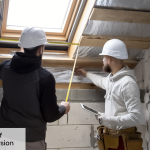When planning a home extension, it is important to obtain the necessary planning permissions before starting the project. In the UK, there are specific house extension rules and building regulations that must be followed to ensure that the extension is legal and safe. Read our article on building regulations for extensions UK.
Building Regulations & Planning Permission for Extensions UK
Planning Permission and Permitted Development
Planning permission is a legal requirement for most home extensions. It is the process of obtaining permission from the local council before starting any building work.
This permission ensures that the proposed extension meets the necessary safety, health, and environmental standards.
Permitted development rights allow homeowners to carry out certain types of building work without requiring planning permission. However, these rights have certain limitations, including the size, location, and height of the extension.
To obtain planning permission, homeowners must apply an application to the local council. The application should include detailed plans of the proposed extension and information on how it will affect the surrounding area.
Common Reasons for Planning Permission Refusals
Planning permission refusals can be due to several reasons, such as the extension being too large or tall, not fitting in with the local area, or impacting on the privacy of neighbours.
Appeals Process If planning permission is refused
Homeowners can appeal the decision to the Planning Inspectorate. This process involves submitting further evidence and providing reasons why the proposed extension should be approved.
Failing to obtain the necessary planning permissions can result in legal issues, as well as costly fines and even demolition of the extension.
Therefore, it is essential to ensure that all the required permissions are obtained before starting any building work.
Building Regulations Rules for different types of Extensions UK
We’ve compiled various home extension rules for different type of house extensions.
Home Extension Rules 2023 for Side Extensions
- Side extension should sit to the side of the house (not front) and should not face a highway.
- The height cannot exceed 4 m.
- It can only be single storey. Multi-storey is not allowed.
- The extension can only be 50% of the width of the existing house.
- The eaves and ridges shall not be taller than the existing house.
Semi detached House Extension rules 2023
These semi detached house extension rules ensure that the extension is safe, doesn’t compromise the structural integrity of the property, and doesn’t have a negative impact on the surrounding area.
- If you plan to build a single storey extension, it can’t extend more than 4 meters from the existing rear wall of the house.
- For double-storey extensions, the maximum extension is 3 meters. Additionally, if your house is located on designated land or in a conservation area, there may be further restrictions on the size and placement of the extension.
- The maximum height allowed is 4 meters. If you plan to build a double storey extension, the height of the extension can’t exceed the height of the existing house.
- The construction materials for the extension should be in keeping with the original property. The design should be sympathetic to the character of the surrounding area.
- If the extension overlooks neighbouring properties, you may need to include privacy measures, such as frosted glass or blinds.
- You will need to obtain a party wall agreement that ensures that the construction doesn’t damage the shared wall.
Terraced House Extension Rules 2023
In most cases, terraced houses fall under permitted development rights, which means that certain extensions can be built without planning permission.
However, there are still some terraced house extension rules to keep in mind.
- Single-storey rear extensions can usually be built without planning permission as long as they do not extend more than 3 metres from the original house for a terraced house, or 4 metres for a detached house, and do not exceed 4 metres in height.
- For double-storey rear extensions, planning permission is required.
- Side extensions are not allowed under permitted development rights, and any front extensions require planning permission.
- If the proposed extension does not fall under permitted development rights, planning permission will be required.
- Party wall agreement may be required, and the house extension must be required to meet the building regulations.
Front House Extension Rules 2023
Generally, planning permission is required for front extensions, so it’s better to check with your local council before starting any work.
Here’s a list of Front house extension rules to be followed.
- Front extensions should be consistent with the character of the area, and they should not detract from the street scene.
- The design and appearance of the front extension should be sympathetic to the existing property and should not harm the visual amenity of the area.
- There are limits on how far a front extension can protrude beyond the building line, and these limits can vary depending on the location and size of the property.
- The height of a front extension should be consistent with the existing property and the surrounding area.
- A front extension should not create access or visibility problems for drivers, cyclists or pedestrians.
- The materials used in the front extension should be of a similar quality and appearance to those used in the existing property, and they should not harm the visual amenity of the area.
- Other regulations, such as building regulations and party wall agreements, may also need to be considered depending on the scope of the project.
Rear House Extension Rules
The size of a rear extension should not exceed 50% of the original house size or go beyond four meters in depth for a detached house, and three meters in depth for a semi-detached or terraced house. It should also be proportionate to the original house.
- The maximum height of a single-story rear extension should not be more than four meters. If the extension has more than one storey, then the maximum height should not be more than three meters.
- The materials used in the rear extension should match the original building as closely as possible. The design of the rear extension should also complement the style of the existing building.
- The rear extension should not obstruct the access or egress of the neighbouring properties.
- The rear extension should not be built within two meters of the boundary of the property unless the neighbours give written consent.
- The drainage and sewage system of the property should be considered when designing the rear extension.
It is essential to ensure that you obtain the necessary planning permissions and building regulations before starting the construction of a rear extension.
Building Regulations UK for Home Extensions
Here are the key building regulations that you need to comply for your home extension project.
Home extension Rules and Regulations for Foundation
Foundations are the prime elements of any building that safely transmit the load of the building to the ground and provide a sound structural stability.
Depending on the requirements and load bearing capacity of soil, the foundations can be:
- Shallow-Fill: Here the minimum thickness of load transfer to soil is provided.
- Deep-Fill: Here the trench is filled completely.
Depending on the practicability and ground conditions, the fill varies from project to project.
There are several other factors that need to be considered while designing the building foundation. These are:
- Type of Soil
- Load-bearing capacity of the soil
- Adjacent structures & Trees
- Drains and sewers
- Ground conditions
- Landfill sites
- Type of the new structure (extension)
Building Control Officers conduct three separate visits by the i.e. at the time of start, excavation and then, at the time of concreting.
Their word is final in all respects and may sometimes override your approved designs.
Building Regulations Rules and Regulations for Ground Floor Extensions UK
The main function of a Ground floor is to bear the load and provide support to structure. Also, it must offer thermal insulation and pose resistance to ground moisture.
The floors in the UK are majorly constructed as the solid floor, suspended timber floor, and suspended concrete floor that uses pre-casted concrete planks.
The building regulations include:
- The floors should be equipped with DPM (damp proof membrane) and should be thermally insulated.
- The joists sizes, beam spans calculations must be done by a structural engineer and should be included in the plan submitted for approval.
- For contaminated grounds such as those contaminated with gases such as radon, these areas need to be well ventilated. An additional gas membrane would be required to stop these harmful gases from entering the building and harming the structure.
Ground Level walls Rules for Home Extension
Depending upon the foundation, a substructure may be constructed below the ground level. The main walls (above the ground) or superstructure will be built on this.
The main objective of building a substructure is to provide adequate support to the superstructure.
This below-ground brick-and-mortar structure should resist frost and underground sulphates.
House Extension Rules for Walls
The main walls or the external walls of the home extension should be all-weather proof which means they should be able to resist whatever weather throws at them.
Additionally, the walls should add to the building’s structural integrity and minimize heat loss.
The strength of the cavity walls depends on the corrosion resistance ability of the wall ties that should be inserted at the proper spacing that will induce thermal bridging.
Internal walls can be stud partitions or load-bearing when structural integrity is the primary consideration.
Whatever the choice, the internal walls should comply with fire resistance and sound insulation regulations.
Additional strict measures may require in the case of multi-storeyed buildings.
Read More: What Are The Building Regulations for Loft Conversion?
Structural Openings Rules for Home Extension
After the newly constructed home extension has been made waterproof, a structural opening is usually made through the existing main/external walls.
This is done by removing the existing window or French door, ensuring that the load on the existing lintel stays the same. Normally, no extra support is needed.
But, for a wide opening, additional support shall be required. This is usually done by using steel beams.
The beams are installed as per the calculations done by the structural engineer and are mentioned in the drawings.
These structural components, such as timber or steel, need to be fireproof to give them an additional resistance of at least 30 minutes to fire breakout.
House Extension Rules for Upper floors
Apart from accommodating furniture, internal walls and occupants, floors play a vital role in providing rigidity to the walls and making the structure lateral resistant.
Your structural engineer or home extension builder in the UK will specify the type of floor, and ceiling joists requirements with correct spacings and spans in the layout plan.
Along with these, acoustics and fire resistance should also comply with building regulations.
House Extension Rules for Single Storey 2023
According to revised regulations and rules for single storey house extension, these extensions must not extend more than 4 m beyond the rear wall of the original house if it’s a detached house, or three metres for any other house.
With prior approval and not on the mentioned land, the limit for single-storey rear extensions increases to eight metres for a detached house, or six metres for any other house.
Prior approval application is necessary to inform the relevant Local Planning Authority of the proposed work. Additionally, the height of single-storey rear extensions must not exceed four metres.
House Extension Rules for More than one Storey 2023
Extensions exceeding one storey in height must not surpass the rear wall of the original property by more than 3 meters or be located within seven meters of any boundary opposite to the rear wall of the house.
The roof pitch should exactly match the existing house as closely as possible.
If an upper storey is built on an existing extension, the roof pitch should still match the original house. Upper-floor windows located in a ‘side elevation’ should be obscure-glazed and non-opening, unless the opening part is more than 1.7 metres above the floor.
Any side extension that is more than one storey high requires householder planning permission.
Home extension Rules for Roofs
Along with dimensions, spacings and spans of the roof, the UK Building Regulation also demands compliance to type/quality of timber used, and specifications of steel beams used for roof structures.
According to the regulations, the roof coverings such as slates, tiles or flat roof membranes should be weatherproof and appropriate for the roof pitch.
A breather membrane underlay is also desired to ensure correct levels of insulation and ventilation.
Proper flues must be designed to ensure the combustion gases escape safely.
House extension rules for Windows and Doors
The building regulations UK for windows and doors cover compliance to everything from ventilation, thermal efficiency, and fire safety to guard rails, glazing safety, security, and sound insulation.
Suitable guard rails are required for French windows or balconies.
Home Extension Building Regulations and Rules for Ventilation
The home extension should be well-ventilated to ensure proper health and to make the space airy.
While inserting/constructing a new wall, proper care should be taken that so that it should not impact the ventilation of the other rooms.
Adequate extract ventilation should be provided for bathrooms, kitchens, utility rooms or toilets to reduce congestion and condensation levels and remove smells.
Stay tuned to read building regulations for triple storey extensions. Till then, read information about triple storey extension.
TEL Constructions- The most trusted and professional Home Extension Builder in UK
Home extension is a perfect solution to address space issues as it not only adds to the aesthetics but also increases your property’s value. Wanna go for a home extension but are unsure about the UK building regulations compliance?
We, at TEL Constructions, are the UK’s most trusted, professional and reputed home extension builder and construction contractor since 2011.
Our skilled and in-house extension experts ensure a seamless transition between your current one to the space of your dreams with 100% compliance with building regulations.
Drop a line or call us to build the space you’ve always desired!
POV: Designers and architects are familiar with building regulations for extensions, while construction companies have a better edge as they have ample experience and exposure.
Bottom Line
Decided about the home extension? Get your plans approved by your local council’s Building Authority before commencing the work.
Complying with home extension rules and building regulations has an added advantage: it becomes easier to incorporate changes at the design phase rather than forcing them in the later stages.
Reaching out to a reputed construction firm will ensure the smooth execution of your home extension project while you stay assured that all building regulations have complied.
 06 September 2024
06 September 2024 06 September 2024
06 September 2024 05 June 2024
05 June 2024 05 June 2024
05 June 2024 05 June 2024
05 June 2024



mangat